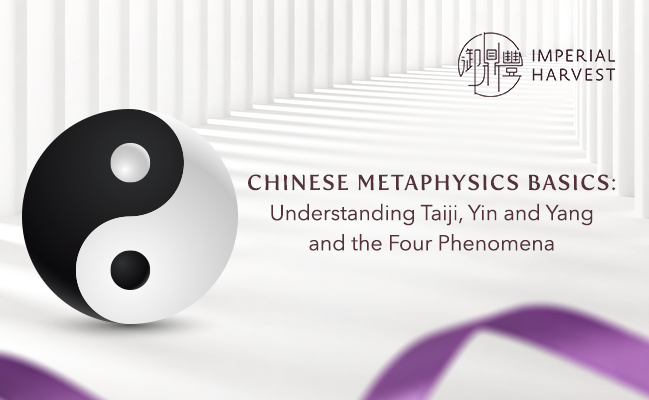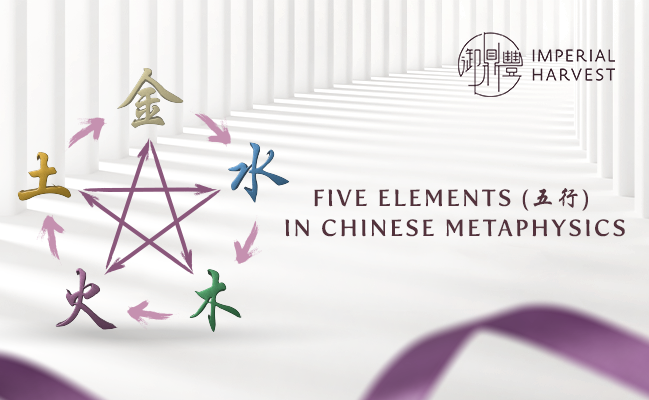

Posted by Imperial Harvest on 25 August 2023
Understanding Bagua (八卦)
Estimated Reading Time: 4 mins
As we previously covered in our Chinese Metaphysics basics, we explained that the concept of Taiji (太极) forms the foundation of our contemporary understanding of Imperial Feng Shui.
The significance of Taiji is best summarised in the following: “无极生太极,太极生两仪,两仪生四象,四象生八卦”, describing the process in which the Eight Trigrams were formed.
Bagua (八卦) — also known as the Eight Trigrams — originate from the Four Phenomena (四象) representing the states of earthly matter. These phenomena derive from Yin and Yang, the opposing poles. Their complementary energies form Tai Ji (太极), the binary state of the universe. Therefore, the Eight Trigrams is derived from the interactions between Yin and Yang.
About the Eight Trigrams
The Eight Trigrams draw from philosophies surrounding I-Ching, Taiji and the Five Elements (五行). This principle was used to understand the interactions and relationships of the natural world, as referenced by its significance in Chinese astronomy, divination, Feng Shui, astrology, anatomy and Chinese medicine, amongst others.
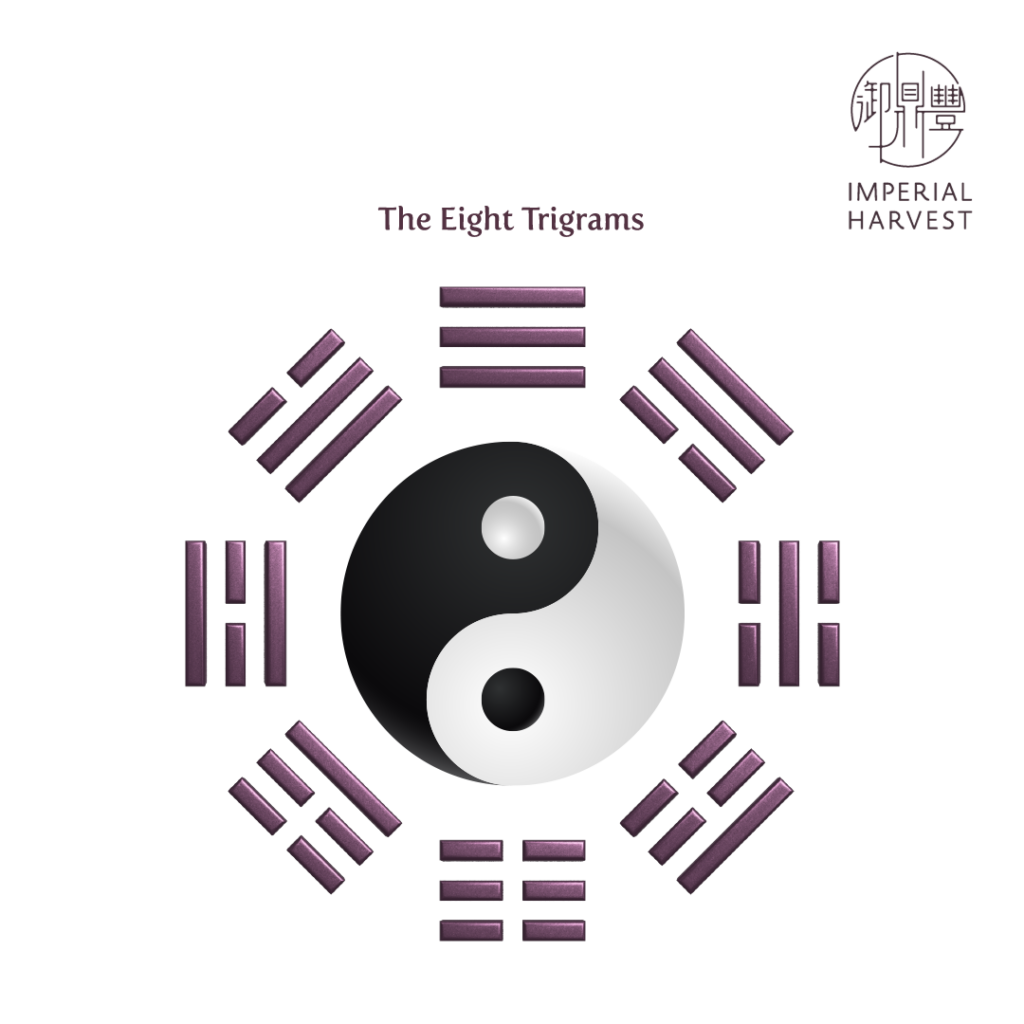
According to Chinese metaphysics, the Trigrams represent the fundamental principles of reality and existence, manifesting as eight interrelated concepts. Each of the Bagua (八卦) is visualised as three horizontal lines — known as yao (爻) — which are either “broken” or “unbroken”, representing Yin or Yang respectively.
The Taiji universe comes into existence by replicating the polarities of Yin and Yang, resulting in the creation of the Four Phenomena (四象):
- Major Yang (太阳), represented as ⚌
- Minor Yang (少阳), defined as ⚎
- Major Yin (太阴), visually represented as ⚏
- Minor Yin (少阳), defined as ⚍
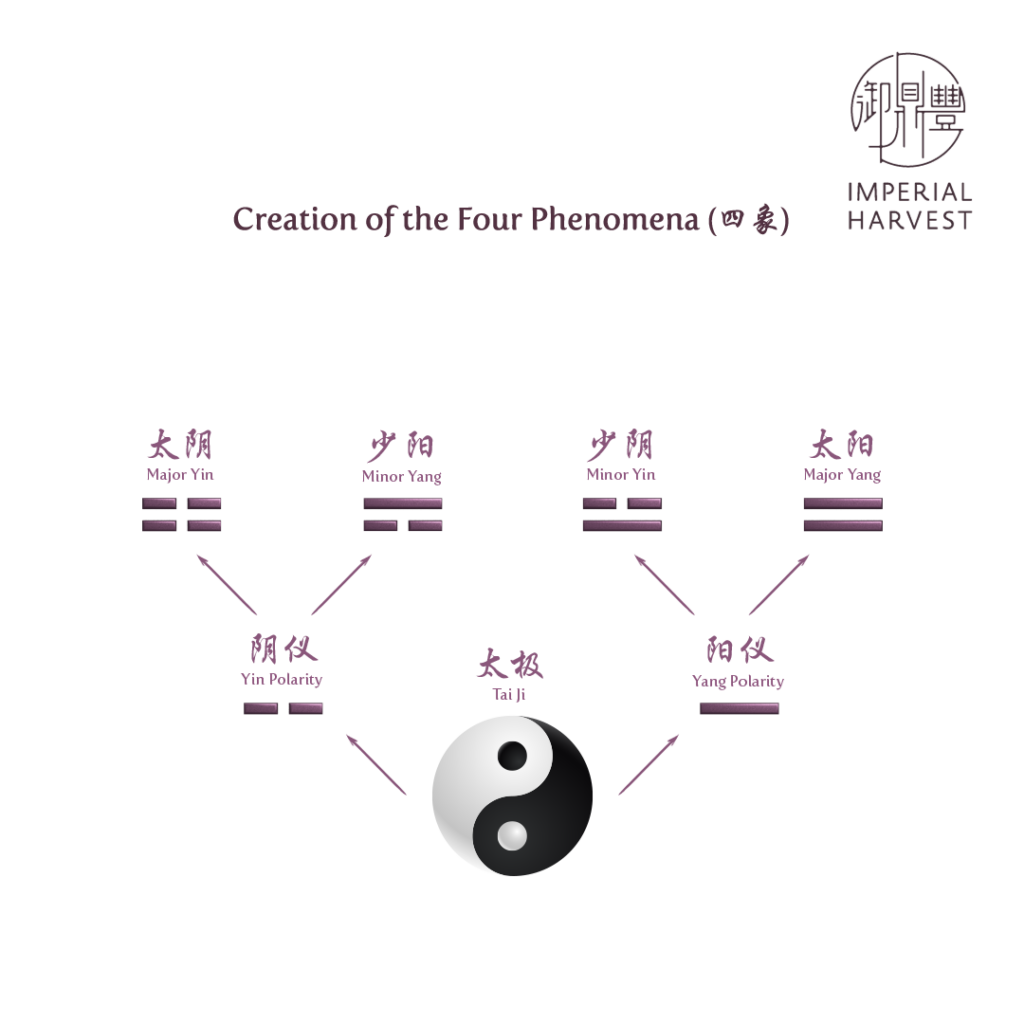
How was the Bagua formed?
Following the pattern of expansion seen in the birth of the Four Phenomena through Yin-Yang polarities, we can now explore how these Four Phenomena interact with its polarities to give rise to the Eight Trigrams.
- Qian Trigram (乾卦): Starting with the Yang polarity (ー), it is divided into Major Yang (⚌). The introduction of additional Yang energy, combined with its inherent energies, gives rise to the Qian Trigram, visually represented by (☰).
- Dui Trigram (兑卦): Beginning with the Yang (ー), which is further divided into Major Yang (⚌). This energy then interacts with Yin, which forms the Dui Trigram, represented by the symbol (☱).
- Li Trigram (离卦): Yang energy (ー) interacts with Yin, forming Minor Yin (⚍). This energy further interacts and combines with its inherent Yang energy to form the Li Trigram, represented by (☲).
- Zhen Trigram (震卦): The Yang energy interacts with Yin energy, the Minor Yin (⚍). However, this energy instead interacts and is further combined with Yin energy, giving rise to the Zhen Trigram. It is visually represented by the symbol, (☳)
- Xun Trigram (巽卦): Beginning with the Yin polarity (- -), it interacts with Yang energy to form Minor Yang (⚎). It further melds with inherent Yang energies to form the Xun Trigram, represented by the symbol (☴).
- Kan Trigram (坎卦): Yin (- -) interacts with Yang energy, forming Minor Yang (⚎). It further interacts with its inherent Yin energy, forming the Kan Trigram, represented by (☵).
- Gen Trigram (艮卦): Yin energy interacts to form Major Yin (⚏), combining with Yang energy to form the Gen Trigram (☶).
- Kun Trigram (坤卦): The Yin polarity (- -) is divided into Major Yin (⚏). The introduction of additional Yin energy, combined with its inherent energy, gives rise to the Kun Trigram, visually represented by (☷).
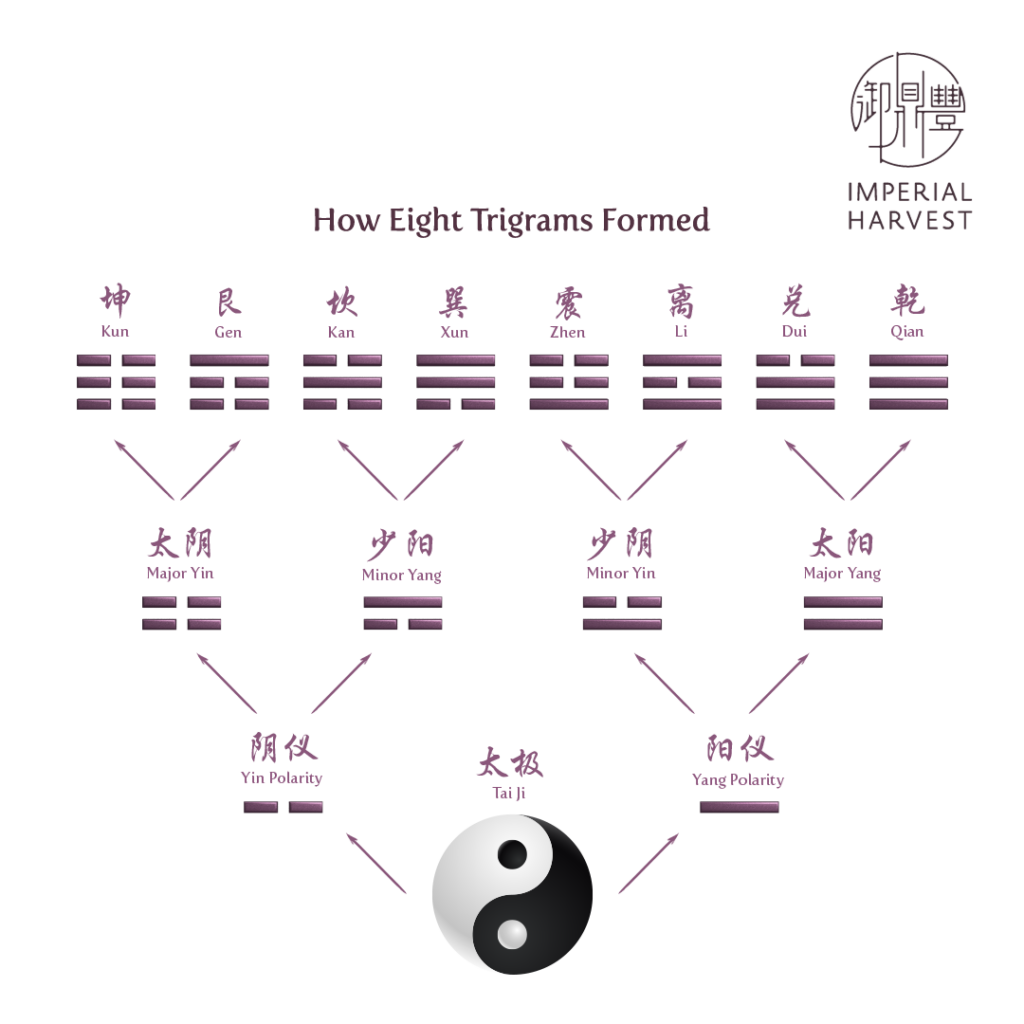
The Eight Trigrams are each associated with a designated number, which forms the following order: 乾 Qian (☰, 1), 兑 Dui (☱, 2), 离 Li (☲, 3), 震 Zhen (☳, 4), 巽 Xun (☴, 5), 坎 Kan (☵, 6), 艮 Gen (☶, 7), 坤 Kun (☷, 8).
Representations of the Bagua
According to the principles of Chinese metaphysics, the Eight Trigrams are intertwined with different aspects of the natural world, traditional Chinese medicine and interpersonal relationships.
Some associations of the Eight Trigrams are as follows:
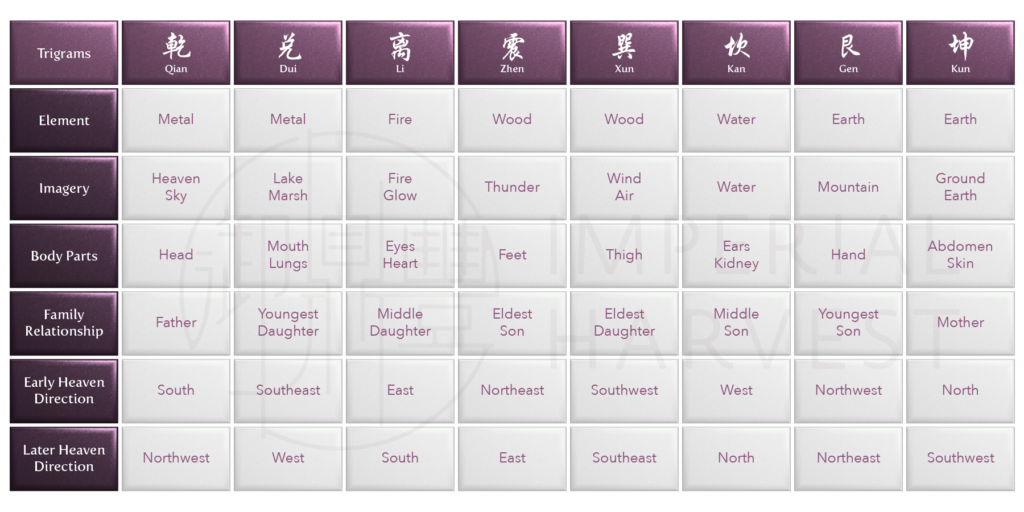
The Eight Trigrams are commonly arranged and presented in one of two ways: Early Heaven Bagua (先天八卦) and Later Heaven Bagua (后天八卦).
Early Heaven Bagua is often used in divination, associated with the seasons, or time. It correlates with the model of the Universe in its optimal state, where every element and phenomena are in complete equilibrium and harmony.
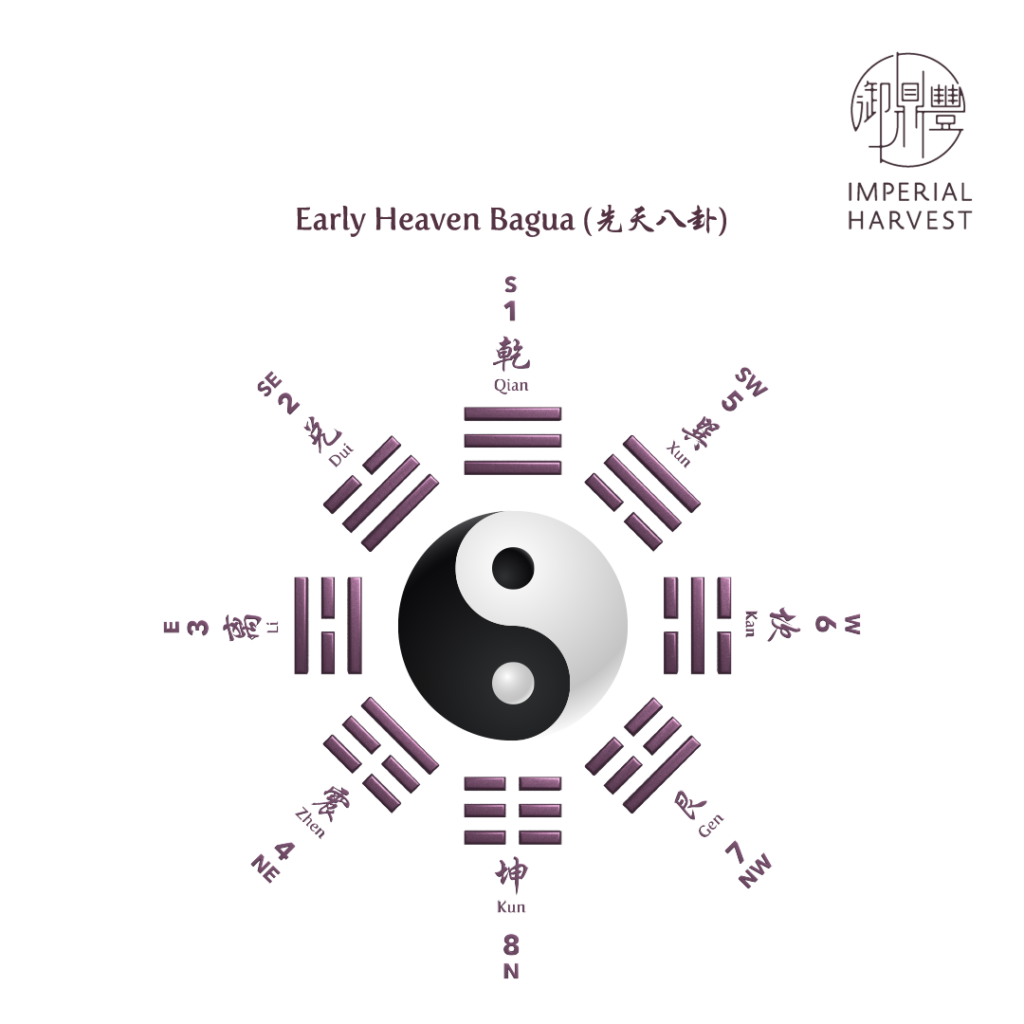
In the arrangement of Early Heaven Bagua, the Qian Trigram, representing Heaven, is positioned at the top. Whereas the Kun Trigram, representing the Earth, occupies the bottom. Historically, the top position on Chinese maps represented the South. On the left of the chart is the Li Trigram, positioned facing the Kan Trigram, representing the conflicting natures of Fire and Water. Another pair is formed by the Zhen and Xun Trigrams, representing thunder and wind respectively. The final pair in the Early Heaven Bagua arrangement is the Gen and Dui Trigrams, which represent mountains and lakes.
This arrangement maintains symmetry and exact opposition among the Eight Trigrams, collectively symbolising the contrasting forces of Yin and Yang, representing an ideal state of equilibrium and balance.
On the other hand, Later Heaven Bagua is often utilised in Feng Shui, due to its close association with aspects of direction and space. It represents the unfolding of the human experience, the dynamic flow of energy, and the ever-changing patterns of the environment. In Later Heaven Bagua, the Li Trigram is situated at the top of the chart, while Kan is situated in the North position, at the bottom.

Contemporary Usage of Bagua
In the practice of Imperial Feng Shui, skilled Imperial Feng Shui masters adeptly utilise the contrast between the Early Heaven and Later Heaven Bagua to enhance the Qi flow within a space.
This accumulated Qi is believed to attract a significant number of individuals, a principle applied in contemporary architecture and interior design. From this juxtaposition, Imperial Feng Shui masters can predict certain life events by considering the arrangement of landmarks in relation to a property’s orientation.
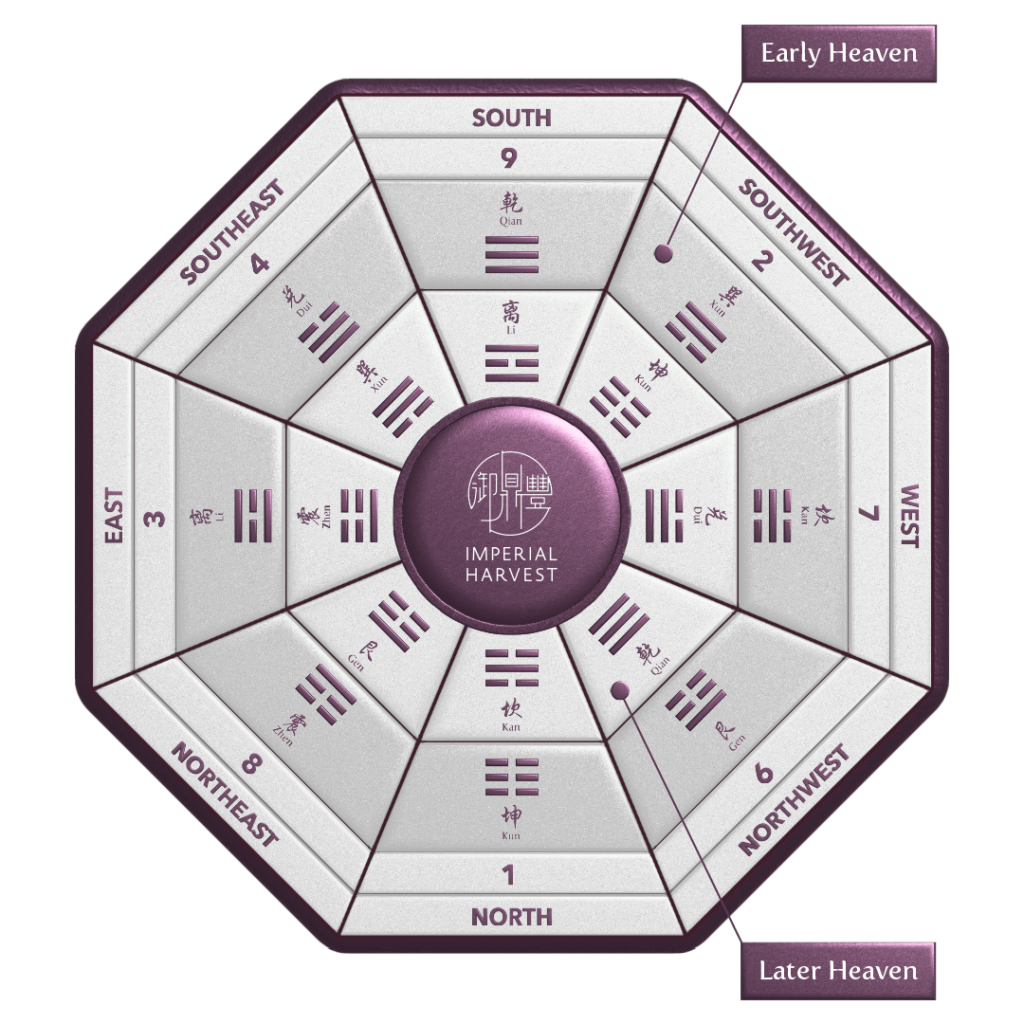
As depicted in the above image, the inner ring of the Bagua represents Later Heaven, whereas its outer ring represents Early Heaven. These two concepts are interconnected in Chinese metaphysics.
The South direction is represented by the Li Trigram in Later Heaven and the Qian Trigram in Early Heaven. The South direction is also linked to the Northwest, with the Qian Trigram represented in Later Heaven. It is also represented in the East direction by the Li Trigram in Early Heaven.
Therefore, if a property unit can link the three Early Heaven and Later Heaven combinations by opening a window or a door in its South, Northwest and East sectors, it allows the Early Heaven and Later Heaven Bagua to converge, and enhance the Qi energy within the confines of the space — creating an auspicious environment.

These predictions, based on specific Trigrams, can indicate any effects of Sha Qi — or inauspicious energy — on a property space. It can indicate potential health issues affecting specific family members. The application of Early Heaven and Later Heaven Bagua extends to predictions based on the months or years according to specific Trigrams. This allows Imperial Feng Shui masters to ascertain other extenuating circumstances in the household.
In the intricate tapestry of Chinese metaphysics, the Eight Trigrams stand as timeless symbols that weave together the fundamental forces of the universe. These symbolic arrangements have guided sages and scholars for centuries, offering insights into the dance between Yin and Yang, the interplay of energies, and the ever-shifting dynamics of existence.
Imperial Harvest’s expert consultants are always on hand to guide you on your journey and provide you with insights to help you realise your fullest potential. Book a complimentary consultation today or contact us at +65 92301640.
We are located at
For prospective clients: Imperial Harvest402 Orchard Road
Delfi Orchard #02-07/08
Singapore 238876 For existing clients: Imperial Harvest Prestige
402 Orchard Road
Delfi Orchard #03-24/25
Singapore 238876
Most Read Articles
Get to read our life changing articles and get inspired.
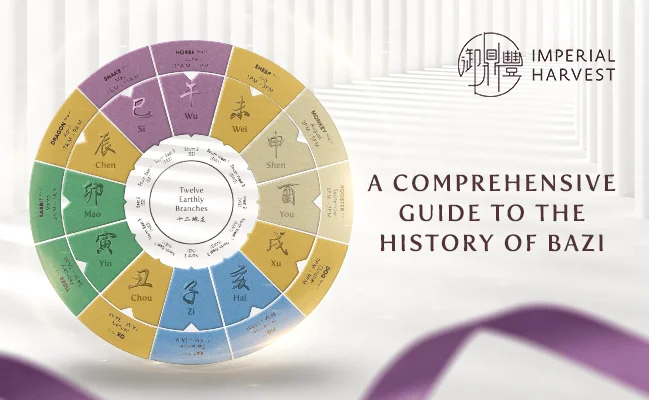
A Comprehensive Guide to the History of Bazi (八字)
Estimated Reading Time: 5 mins Bazi (八字) is often mistakenly assumed as the Chinese counterpart of western Astrology. The similarities between both systems lie in their utilisation of birth dates and time in their calculations, and the ability to be read from a tabulated chart. Where Astrology may take into account the positions of different […]

Imperial Harvest Consecration Ceremony
Estimated Reading Time: 5 mins At Imperial Harvest, each earthly treasure undergoes a series of consecration rites performed by Master David, before it is bestowed upon its blessed owner. Every aspect of these sacred Chinese anointing rituals is carefully examined and accurately represented in Master David’s blessings, reflecting Imperial Harvest’s deep respect for these esteemed […]

The Importance of Mountain and Water Stars
Estimated Reading Time: 4 mins “山管人丁,水管财”, is a well-cited principle in the study of Imperial Feng Shui that translates to “Mountains govern benefactors, authority and harmony, while Water governs wealth, opportunities and intuition”. This principle reiterates a critical factor in Imperial Feng Shui — balance is the key to achieving success in life. As mountain […]
